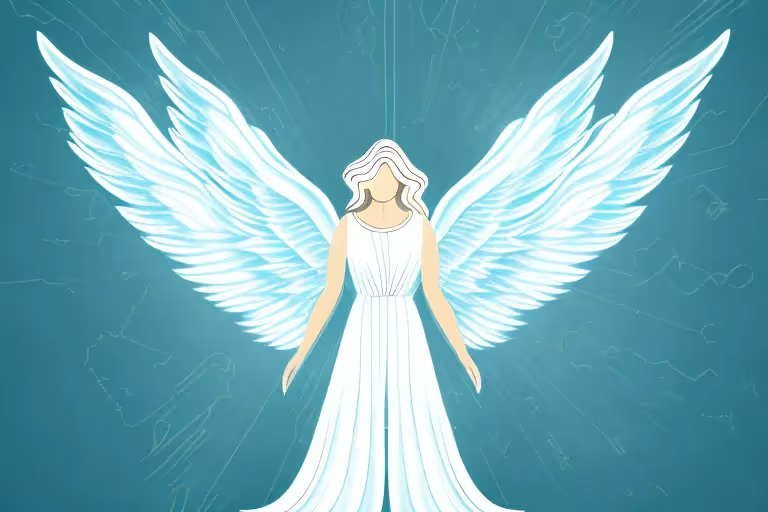Listen up, folks! Have you ever wondered about those winged creatures we always see in religious art? Those ones with six holy wings and a fiery disposition? Well, wonder no more because we are diving deep into the world of Seraphim angels. Get ready for some divine revelations and a whole lot of laughs!
The Origins and History of Seraphim Angels
First things first, let's talk about where these angelic beings came from. Believe it or not, the first mentions of Seraphim are in the Bible. That's right, ladies and gents, the Bible. Apparently, these fiery creatures were tasked with singing praises to God and were considered the highest order of angels. Talk about a high-pressure job!
But wait, there's more! The word "Seraphim" actually comes from the Hebrew word "seraph," which means "fiery ones." And let me tell you, they lived up to that name. According to Jewish mythology, these angels were so hot (pun intended) that they could incinerate anything in their path. I don't know about you, but that seems like a pretty intense power.
Biblical References to Seraphim
Now, let's dive a bit deeper into the Bible and see what it has to say about these heavenly beings. In the book of Isaiah, there's a passage that describes Seraphim as having six wings. That's twice as many as a regular angel, in case you were wondering. These wings were used to fly, cover their faces (presumably because of their intense heat), and cover their feet (because even angels need some foot privacy, am I right?).
But that's not all. The passage goes on to describe how these Seraphim angels called out to one another with the phrase "holy, holy, holy." Can you imagine living your entire life solely devoted to singing praise to God and only saying one phrase? Talk about a limited vocabulary.
The Role of Seraphim in Ancient Cultures
Now let's take a little trip back in time to uncover how these winged creatures were viewed in ancient cultures. According to Egyptian mythology, there were beings called "Serpahs" (notice the spelling difference) that were depicted with the body of a serpent and the head of a human. They were often depicted guarding tombs as they were believed to have the power to protect the dead from evil spirits.
Similarly, in Persian mythology, there were beings called "Karshaspas" that were believed to be fiery beings that protected the world from harm. Sound familiar?
It's interesting to note that despite the differences in cultures and beliefs, there are similarities in how these winged beings were viewed. Perhaps this is a testament to the power and influence that Seraphim angels have had throughout history.
Evolution of Seraphim Depictions in Art and Literature
Now let's fast forward a bit to how Seraphim angels have been depicted in art throughout history. In medieval art, Seraphim were often depicted with red wings and a blue robe, symbolizing their fiery nature and divine status. But as we moved into the Renaissance period, their appearance changed. Wings became more feather-like and the robes became more ornate and detailed.
It's fascinating to see how the depictions of Seraphim have changed over time, reflecting the evolution of art and culture. From the fiery, intimidating beings of medieval art to the more delicate and intricate depictions of the Renaissance, Seraphim have remained a popular subject for artists throughout the ages.
In literature, Seraphim have been featured in numerous works throughout the ages, including John Milton's "Paradise Lost" and C.S. Lewis's "The Chronicles of Narnia." It seems like these fiery creatures have captured the attention of artists and writers alike.
Overall, the history and evolution of Seraphim angels is a fascinating subject to explore. From their origins in the Bible to their depictions in art and literature, these winged beings have captured the imagination of people throughout history. Whether you view them as fiery protectors or divine singers, there's no denying the impact that Seraphim have had on our culture and beliefs.
Characteristics and Features of Seraphim Angels
Now that we've covered the history, let's move onto the juicy details - what do these angels actually look like and what makes them so special?
Physical Appearance and Symbolism
As we mentioned before, Seraphim are often depicted with six wings, but what else makes them stand out from the crowd? Well, according to some sources, they are also described as having a human face and the body of a lion or a serpent. That's right, folks, we've got some angelic lion-snake hybrids on our hands.
The lion and snake symbolism has a deep meaning behind it. The lion symbolizes strength and courage, while the snake is often associated with wisdom. Seraphim angels are known to be the embodiment of these qualities. They are fierce and powerful, yet wise and intelligent. The combination of these traits makes them one of the most revered and respected angelic beings.
The Six Wings of Seraphim
Let's not forget about those six wings. According to Christian tradition, two of the wings are used to cover their faces, two are used to cover their feet, and the remaining two are used for flying. However, in Jewish tradition, the two wings used for flying are actually used for protection. This shows that Seraphim are not only powerful, but they are also protectors of the divine realm.
The six wings of Seraphim also have a symbolic meaning. The two wings that cover their faces represent their reverence and respect for God. The two wings that cover their feet represent their humility and unworthiness in the presence of God. And finally, the two wings used for flying represent their ability to ascend to the highest realms of heaven.
The Fiery Nature of Seraphim
We've mentioned their fiery nature a few times now, but what exactly does that mean? Well, some sources suggest that Seraphim are so hot that they emit pure light from their bodies. This light is said to be so bright that it can blind human eyes. Others suggest that they have the power to incinerate anything that comes into contact with them. Safe to say, you definitely don't want to mess with these guys.
The fiery nature of Seraphim represents their passion and devotion to God. They are often described as burning with love for their creator and are constantly in a state of worship. This is why they are considered to be some of the most powerful and holy beings in the divine realm.
The Hierarchy of Angels and the Role of Seraphim
Now that we know what sets Seraphim apart from other angels, let's talk a bit more about their role in the hierarchy of angels and what they actually do.
The Nine Choirs of Angels
According to Christian tradition, there are nine choirs of angels, each with their own specific duties and responsibilities. At the top of the hierarchy sit the Seraphim angels, followed by the Cherubim, Thrones, Dominions, Virtues, Powers, Principalities, Archangels, and finally, Angels. That's quite the organizational chart.
Seraphim as the Highest Order of Angels
As we've mentioned before, Seraphim are considered to be the highest order of angels. Their job is to worship and praise God, and according to some sources, they also have the power to purify individuals of sin. Not bad for a day's work.
The Duties and Responsibilities of Seraphim
So, what do these fiery beings actually do on a day to day basis? Well, according to Christian tradition, their primary duty is to sing praises to God. But they are also believed to have the power to purify individuals of sin, as we mentioned before, and some sources suggest that they act as messengers between God and humanity. Talk about a prestigious job title.
Seraphim Angels in Religious and Spiritual Practices
Finally, let's talk about how Seraphim angels are viewed and utilized in various religious and spiritual practices around the world.
Seraphim in Christianity
Unsurprisingly, given their prominence in Christian tradition, Seraphim are often featured in Christian art and are frequently referenced in religious texts. They are seen as holy and awe-inspiring beings that are tasked with carrying out God's will.
Seraphim in Judaism
In Judaism, Seraphim are believed to be one of the four angels that surround God's throne. They are seen as holy and powerful beings that are tasked with praising God and carrying out His will. Some sources suggest that they also protect the throne of God from evil forces.
Seraphim in Islam
In Islam, Seraphim are referred to as "Mala'ikah" (angels) and are tasked with carrying out various duties assigned to them by God. They are often referred to as being beautiful and luminescent, which is not surprising given their fiery nature.
Seraphim in New Age Spirituality
Finally, in New Age spirituality, Seraphim are often seen as powerful and transformative beings that can help individuals connect with the divine. They are believed to radiate pure love and are seen as guides that can help individuals on their spiritual journey.
Wrapping it Up
So, there you have it folks, a deep dive into the world of Seraphim angels. From their fiery nature to their prestigious job title, these winged creatures are truly awe-inspiring. Whether you view them as holy beings or as powerful guides on your spiritual journey, one thing is for sure - you definitely don't want to mess with a Seraphim angel. If we've learned anything from this article, it's that they're hot stuff (pun intended, again).
Aura is Your All In One App for Meditation, Mindfulness Wellbeing
Find peace every day with one app for your whole well-being. There is no one-size-fits-all solution to mental well-being. Aura is the first all-in-one wellness app that learns how to best help you. Discover an endless library of expert-created tracks for your well-being, all taught by the world’s best coaches, therapists, and storytellers. With Aura's personalized recommendations, you can find peace every morning, day and night.



.webp)






.avif)

%20(1).avif)


.avif)
.avif)
.webp)


.avif)


















































































































.avif)

















.svg)









